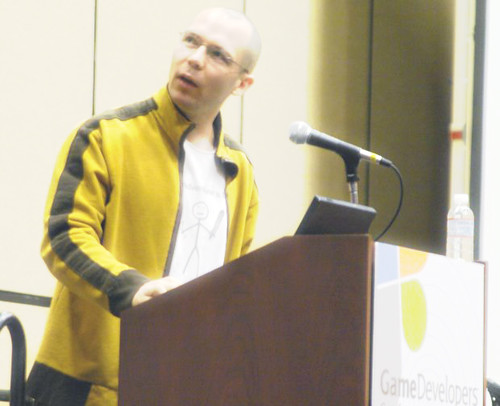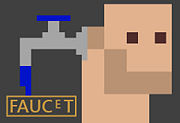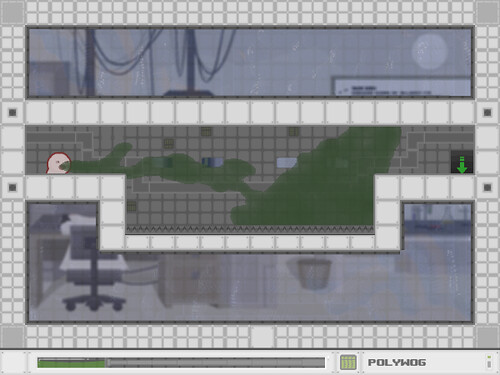Posts from ‘Platformers’ Category
Mega man 2.5D
By: Xander
On: May 29th, 2009
Peter Sjostrand’s Mega Man 2.5D sadly doesn’t have a playable public build yet, but this video uploaded just recently was enough to get me excited enough to post it. It seems to reimagine Mega Man 2 as a Paper Mario style platforming adventure, with a number of interesting play twists on the original’s classic layout. A few of the pictured sequences involve a seamless transition between stages of the Mecha Dragon fight, and a usage of the conveyor belts in order to move Mega Man around between the foreground and background. It seems the Blue Bomber is only capable of movement in his regular dimensions so the only way to explore requires using the changing environment to his advantage.
(Update: According to commentors and some googling, this appears to not actually be a gameplay video but rather a concept video. Well… shit…)
The most interesting part of the video however is roughly halfway in where the game showcases a sequence from its Mega Man 3 mode, which actually appears to be a co-op adventure with a player controlling either Mega Man or Proto Man. Far from a simple side-scrolling slog with an extra gun, these levels incorporate a number of rather crafty looking puzzles where both characters really must work together to survivor. My favourite part is probably where Proto Man is being attacked from a flying enemy, but he must remain on a button until Mega Man jumps to safety. It looks like a suprisingly tense experience that simply isn’t present in any of the main Mega Man iterations. Suprisingly I’m pretty damn excited for this. A 2009 release? We can only hope.
Chup
By: Derek Yu
On: May 25th, 2009
Chup is a new Flash platformer from DrPetter, the creator of the fantastic music tools SFXR and Musagi. Use the keyboard to move and the mouse to launch yourself into the air. The goal is to reach the exit in each of the 16 levels. You get more points for time, gems, and number of launches used.
DrPetter makes some quality stuff, and Chup is no exception – it’s a challenging game with slick graphics and music.
TIGdb: Entry for Chup
(Source: Dan Tabar, via his Twitter)
Braid Released For Mac
By: Brandon McCartin (BMcC)
On: May 20th, 2009
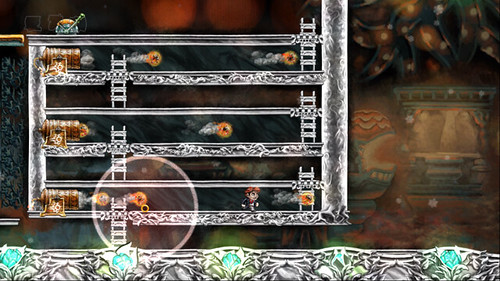
A quick one, for all you Apple eaters: Award winning, time-bending puzzle-platformer Braid has been released for the Mac! You can find it here, at Greenhouse, with a free demo and everything.
A lot has been said about this fine little game, but I thought I’d throw in my two cents, before it’s too late. (After the jump.)
I’ve played through it a number of times now, and really believe Braid is a landmark game. Not just in the realm of “indie” games, but interactive software (or whatever you want to call it) as a whole. It pushes forward in so many ways, particularly in (Jon’s favorite, ha) unifying the naturally divergent forces of Story and Gameplay, while still, at its core, being a wonderfully designed, approachable Game. That’s actually what surprised me most about Braid, at least at first — the “artsy” stuff is there, yes, but strip it all away and you’ve still got a unique, polished, challenging videogame to play. Impeccably designed. (Not to mention that David‘s art also makes it one of the most lovely games I’ve ever seen in motion.) Anyway, yeah, suffice it to say I find it all pretty inspiring!
Can’t wait to see what Mr. Blow comes up with next. (Braid 2?)
Hitlers Must Die! Beta Footage
By: Brandon McCartin (BMcC)
On: May 19th, 2009
Look: In-game beta footage of Hitlers Must Die!, the first track off Cryptic Sea’s upcoming game album, No Quarter. Seems to be coming together rather well! (Those shadows… *swoons*)
FATHOM
By: Brandon McCartin (BMcC)
On: May 18th, 2009

FATHOM, the latest collaboration of Adam “Atomic” Saltsman and Danny “B” Baranowsky, is your standard 2D action-platformer… or is it? The game throws some fun surprises your way, which I don’t want to spoil here, and is definite food for thought. I give it 33 thumbs up!
Like their hit Gravity Hook, FATHOM uses Adam’s Flixel framework for Flash-based 2D games to great effect. (The entire game took about 10 days to make.) Which is cool, because Flixel should see a public release “in a few weeks.” (!) There’s also a bunch of procedural trickery going on in the background which the player may not notice, but I think is worth mentioning in case Adam wants to talk about it more in the forum thread.
TIGInterview: Jonathan Blow
By: Leigh Christian Ashton
On: May 11th, 2009
I’d find it hard to believe anyone visiting these pages would need an introduction to Jonathan Blow, the amazingly talented game developer/guru seems to be everywhere at the moment, his game Braid being the darling hit on Xbox Live and having recently stormed onto the PC. I took the opportunity to fire some questions over so that he could pour some honey into my ears in reply (except, being an email interview, i guess it would be my eyes? and metaphorically at that?)
Anyway, without further ado, please read on..
Leigh: Jon, hello, thanks for taking the time to answer some of my questions. Could you please introduce yourself to the crowd?
Jon: Hi, my name is Jonathan Blow. I make games! I started out in games as mainly a technical guy, but recently I have been thinking ever-more about design, and on Braid I cared much more about the game design than the technical parts.
Leigh: You’ve just released Braid on multiple distribution platforms for the PC. With a longer than average development cycle for an independent developer, you must be pleased to see it finally go out the door?
Jon: It’s nice to have the game (mostly) done. There’s still the Mac port to watch over (though I am not handling the porting of that; Hothead Games is doing it), and the question of whether Braid is going to appear on any other consoles.
Leigh: Though originally developed for the PC, you released Braid first for the Xbox 360, Did this add substantial development time to the project? How complete was the PC version prior to the switch?
Jon: The Xbox 360 version definitely did add substantial development time to the project; there’s a lot of work to do for a platform like that. However, there wasn’t really a “switch”. It was up in the air which platform would be the first release, and eventually I decided on the Xbox 360. At that time the game was pretty much done from end to end, in terms of the number of levels and the puzzle design, though that had been true for a while (the IGF award-winning submission of Braid was the complete game, and that was back in December 2005; I signed with Microsoft in mid-2007). Even after the Xbox 360 was chosen as the target platform, there was a lot of work left to do on the basic game — I was still working heavily with David Hellman to determine how the game would look, and to produce the graphics and do the programming required to place them in the levels.
Leigh: Has the PC version benefited in any substantial way from the inclusion of a port to the 360?
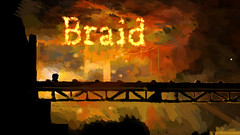
Jon: It was nice to have a solid, well-defined platform to focus on while finishing the actual game part of the game, before having to worry about all the programming involved in dealing with PC compatibility issues. So I think the game benefited some from my being able to focus on a single tangible experience that the user would have.
Leigh: Braid feels like a game you want people to become emotionally engaged in more than just played, do you feel its important for games to be more than a test of skill or memory?
Jon: I wouldn’t ever claim that all games should be a certain way. There are a lot of possibilities for where games can go, and it’s probably a good idea to explore them all.
Leigh: Is it better to elicit emotional responses through gameplay or narrative? Does it matter if either is well done?
Jon: I gave a whole lecture recently about why I think story-based games have a lot of problems. Here’s the link: http://braid-game.com/news/?p=385 . If a designer is thinking about making something emotional through narrative, I would encourage some kind of narrative structure that is not trying to be a conventional linear story. Of course the gameplay route is also full of untapped potential, but there are reasons why it can be difficult to make headway there, which I discuss in the lecture.
Leigh: You spend a lot of time making prototypes of different gameplay mechanics, is it as much about implementation as innovation?
Jon: If you mean about enjoying the craft of programming… I have to admit I don’t really enjoy programming very much any more, because in order to get things done I have adopted a style of programming that makes it as simple as I can, so that it is just easy to get things done, and it only requires time and a lot of typing. So I am not really solving any difficult puzzles or challenges when programming, as beginning programmers might. On the plus side, this means I can program in a relatively efficient manner; on the minus side, it’s a less-engaging activity. I make up for that on the design side; whether I am making a prototype or a full game, it’s about exploring some interesting space of ideas. Programming is now just the implementation detail of how I do that exploration.
It’s not really about innovation so much as exploring interestingness. There is this idea of chasing innovation in game design that I used to be a big proponent of, but that I now suspect is a little bit misdirected.
Leigh: You’re not afraid to throw away cool ideas when they don’t feel right at the prototype stage. A lot of other developers might not be so detached from their ideas.
Jon: These things are true! I try to encourage people to be willing to delete stuff that is mediocre or just kind of good – or at least put that stuff in a closet for some future day – so that they can focus on the stuff that is great. Many people don’t think that way, though. When it is so hard to get anything substantial done, you just don’t want to throw away any of your hard-earned progress. One solution is to make it easier to make progress.
Leigh: Should all games try to innovate? Is re-interpreting the implementation of an innovative new mechanic as valid? I ask because it’s worth noting a number of games have time-play in them now.
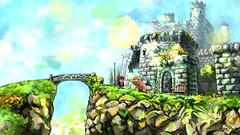
Jon: I think gameplay innovation can result in things that are interesting, but at the same time it doesn’t automatically result in something that is deep — often it’s a gimmick. I am interested in deepness and richness of game design. You can get that with deliberate innovation or without; I think the issues are orthogonal. At the same time, I think if a designer is working on something he really cares about, and is really exploring some ideas in his own style, bringing his own particular insight to the table, then he will automatically come up with something different than most other games; furthermore, this will be a deeper, more-compelling kind of innovation.
That’s what I meant earlier about the deliberate chasing of innovation being a somewhat misguided pursuit. Yes, you can make neat stuff that way, but the innovation will come to you for free if you do things a different way, and you are likely to end up with a different result.
To take a specific example, Braid would be kind of interesting if it were a game with gimmicky time-manipulation mechanics, but I think that many players find it more interesting than that because it is built on a core philosophy and a thorough exploration of a certain set of ideas. Players can feel that, even if they can’t say what the philosophy is or explain the ideas being explored.
Leigh: With talk of innovation and emotional investment, there are still some very conventional design choices like jumping on the head of monsters, moving platforms, ladders, levers and collectables. Is this saying fundamentally there’s not so much wrong with games as they are, they just missing those one or two extra ideas to make them more worthwhile?
Jon: I did these things because they were right for Braid; for another game, I would do something completely different. I don’t think you should take the presence of these elements in Braid as any kind of statement about whether anything is or isn’t wrong with games as they are.
Leigh: Can you talk a little about what inspires your design choices?
Jon: I’d like to, but this is a very broad question. Hopefully in the previous answers I have at least given a little bit of information about this.
Leigh: What about games that you enjoy, are there any real favourites you can say have had an impact on you in some way?
Jon: There are a lot of games that I’ve played that I enjoyed and that influenced the design of Braid. Probably too many to name. Games that currently spring to mind as “favorites” are very different and probably didn’t influence Braid too much (examples: Netrek, and Counter-Strike sometime around the beta 4 – beta 5 timeframe).
Leigh: Since Braid is a platformer, I want to tell you my favourite platformer of all time was The New Zealand Story. Any chance of a remake with time reversal? :)
Jon: I never played The New Zealand Story! Maybe I’ll be able to check it out sometime.
Leigh: Heh, I was only joking, but have you ever wanted to remake any old favorites, felt there was an opportunity missed that you’d like to explore?
Jon: I often get the idea to remake old games, though I usually don’t do it. Actually, though, one of the earlier ideas I was playing with in Braid was that there would be secret levels with remakes of classic games, modified with the time rules of each particular world, accessible when you finished each puzzle. I had an entire remake of Mountain King in Braid at one point. I think it was better than the original Mountain King, with more-sophisticated gameplay, but it didn’t fit what Braid was becoming, so I eventually took it out.
Leigh: Thanks for your time Jon! It’s been really great to hear from you.
Jon: You’re welcome!
Jonathan Blow created Braid for the Xbox 360 and PC which is available now at various digital outlets. You can view the Braid website, Jon has a blog and he is also a workshop organizer at The Experimental Gameplay Workshop
To top it all off, he’s an indie superhero who could talk the hind legs off a donkey, bravo sir!
All Of Our Friends Are Dead
By: Paul Eres
On: May 9th, 2009
All Of Our Friends Are Dead is an atmospheric run and gun platformer. It’s pretty short (I finished it in under two hours), and what’s going on isn’t very clear, but it does a good job at immersing the player into a strange alien world and has nice and stylized visuals. To me it felt like a cross between Glum Buster and the final alien levels of Contra and Super C.
Though it’s not just a “zen platformer” as moi in the forums described a particular type of game, which I took to mean games like Knytt and Seiklus: there’s too many shooting enemies, precise platform jumps, bosses, and deaths from spikes for the player to zone out while playing it. But it shares their emphasis on carefully building up a strong sense of the game’s world and atmosphere with little interesting touches.
My only minor complaint is that the movement is a bit too slippery, causing me to fall into spikes unless I’m precise about it. But thankfully the emulator-style quicksave/quickload feature means that’s not a big problem. That and I wish the game were longer, as is often the case with games I like.
EDIT: Here’s a mirror for those who are annoyed by RapidShare. Also this is the willhostforfood download. Don’t download the first download in that forum thread, it’s v0.9, instead get v1.1 at one of the above links.
Gang Garrison 2.1
By: Derek Yu
On: May 7th, 2009
There’s a new version of the multiplayer Team Fortress 2 demake Gang Garrison. It’s feature-packed:
And here’s a bit more good news: the Team Fortress 2 guys have nothing but good things to say about this latest release (probably to the chagrin of many lawyers)! Faucet and its community are also hard at work other open-source projects, like Left 4 Dead, Garry’s Mod, and Portal demakes (Magenta Box?). Hit up the first link for more information on how to participate.
TIGdb: Entry for Gang Garrison
Spewer
By: Derek Yu
On: May 6th, 2009
Spewer is the latest release from Edmund McMillen, and in my opinion, his most mature… design-wise! Thematically, it’s a puzzle platform game about a lab animal that pukes and eats its own puke, which can easily serve as a metaphor for the way game designers are forced to consume and regurgitate each other’s ideas to get ahead, or how players are simply animals subjected to cruel experiments created by game developers. Or maybe it’s just gross and funny. Either way, the mechanic is fresh and is stretched very well across the game’s 50-odd levels. Big props to the game’s programmer, Eli Piilonen, who did some impressive work with the physics. It handles great.
The game runs in a browser and is also available as a standalone executable and Flash file.
TIGdb: Entry for Spewer
Paper Moon Out on Blurst
By: Derek Yu
On: May 1st, 2009
Great news – Paper Moon has been released on Blurst! The game, which features lovely black and white paper cut-out graphics, began as a short demo for Gamma 3d, but has been fleshed out in a collaborative effort between IA and Flashbang Studios, and makes use of Blurst’s recently added online leaderboards. Big pimpin’ Adam Saltsman (Gravity Hook) was responsible for much of the game’s original graphics.
As much as I enjoy Flashbang’s games, variety is the spice of life and Paper Moon is a great addition to their growing arsenal of fun, Unity-based web games. I hope there are more collaborations on the way!

